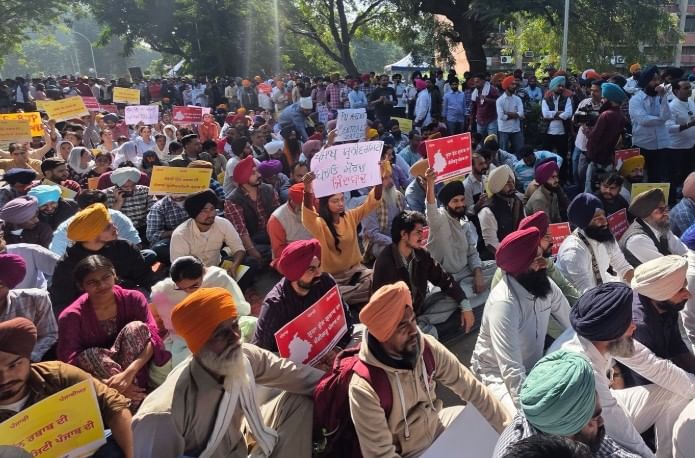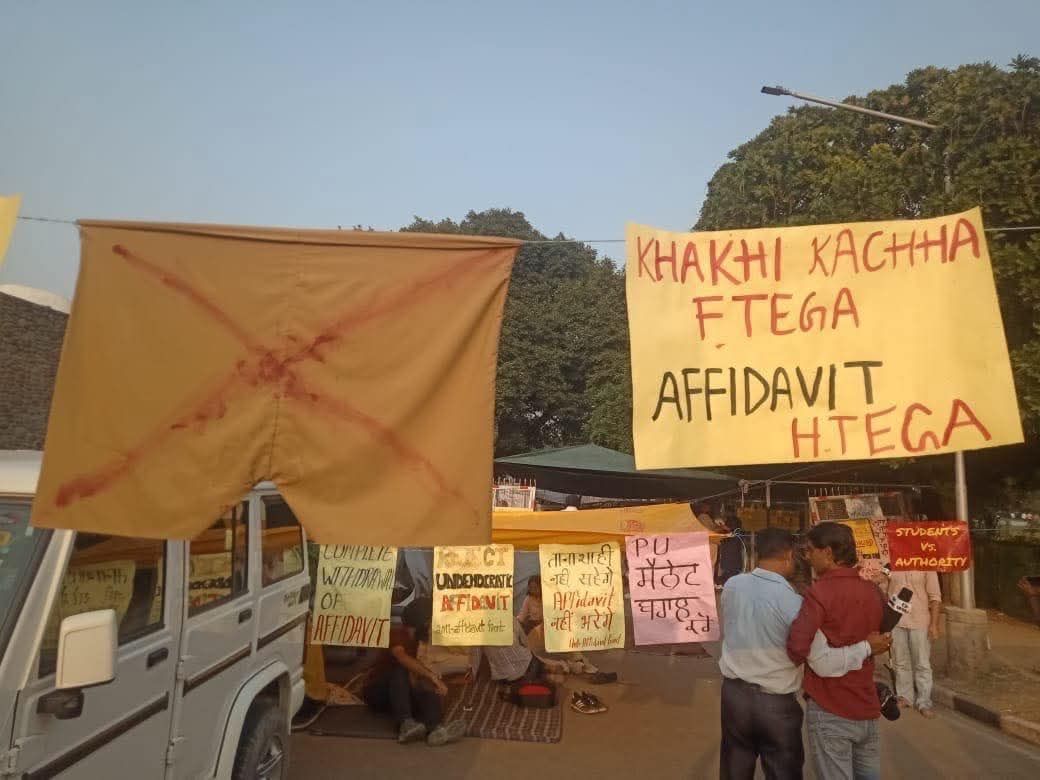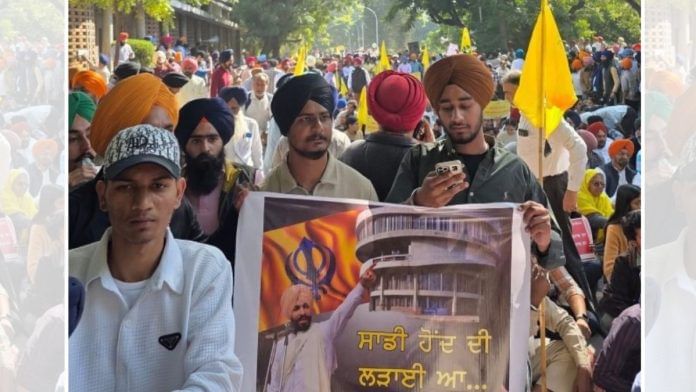Chandigarh: It’s one of India’s oldest universities, with a rich historical legacy. So when the Centre made a move to centralise it, Punjab was not going to take it lying down. Hundreds of students and others hit the street last week. They had a clear message—the university is Punjab’s historical legacy; any attempt to shake that bond was unacceptable.
The slogans weren’t just aimed at reclaiming their university, but also the very identity of Punjab. “Mithi dhun rabab di; Panjab University Punjab di. Sooha phul gulab da; Chandigarh Panjab da (Sweet is the melody of the rabab, Panjab University belongs to Punjab. Red is the rose, Chandigarh belongs to Punjab),” the protesters chanted.
The roots of the protest lie in the Centre’s 28 October move to modify the composition of the syndicate and the senate—the university’s two decision-making bodies—from elected bodies to nominated ones. Many protesters said it was the Centre’s “insidious” attempt to “saffronise” an institution built with generous grants of Punjab’s 18th-century nobility, and later, when it shifted from Lahore to Chandigarh, on land acquired from Punjab villages.
“This university was created after destroying 28 villages of Punjab, and no one can stop us from reclaiming our land… The Centre wants to rob us of our universities, our waters, our farm lands. And, we will not let that happen,” said Ashmeet Mann, the student council’s newly elected vice president, addressing students ahead of the 10 November protest.
AAP MP from Anandpur Sahib Malvinder Singh Kang, who started his political career from the Panjab University as the president of the students council joined the protesters Monday. “How can the BJP-led Centre alter the university’s democratic set-up without consulting the Punjab Government, when the existing Senate structure was duly endorsed by the Punjab Vidhan Sabha under the Panjab University Act of 1947. This brazen act is not reform, it is subversion. Panjab University is the intellectual and emotional heritage of Punjab, not a political playground for centralised control. This move exposes the BJP’s ulterior design to systematically snatch Punjab’s institutions and erode its constitutional rights,” he said.

The 143-year-old university, which counts former Prime Minister Manmohan Singh among its alumni, has grown dramatically over the decades. Starting with only 464 students in 1883 to over two lakh students today of which 20,000 study in the Chandigarh campus alone. One of the most coveted university for students from Punjab, Haryana, and Himachal Pradesh, the university has more than 200 affiliated colleges. When the university started, it offered limited courses in Arabic, Sanskrit, Persian, and Punjabi languages, besides courses in Indian medicine and a basic course in civil engineering.
Today, the university’s affiliated colleges and another 75 departments on the campus offer top courses in languages, arts, science, medical, dentistry, management, communication, music, engineering, architecture, pharmacy, and law.
Panjab University was established in undivided India’s Lahore in 1882. It was the fourth university set up in British India after universities in Calcutta, Bombay, and Madras in 1857. But the story of its origin was markedly different.
Professors R.R. Sethi and J.L. Mehta, who wrote A History of the Panjab University Chandigarh 1947-1967, noted, “Panjab University differed from the earlier universities … while the three universities were wholly sponsored by the government and established through official efforts, the Panjab University was largely a product of the initiative and efforts of the people of Punjab and from this point of view its establishment can rightly be regarded as a national event in the history of modern education in India.”
Panjab University was the only Indian university to be divided, following India’s Partition in 1947. Since the parent campus was in Pakistan, the university started functioning in India from a makeshift campus first in Shimla, then Solan, then Rohtak, and later Hoshiarpur, before being housed in its current campus in the city of Chandigarh in 1958.
Today, the university’s sprawling 550-acre campus, designed by Swiss architect Pierre Jeanneret under the general guidance of Swiss-French architect Le Corbusier, is known for the distinctive modernist architecture of its red sandstone buildings.
“The brick-by-brick rebuilding of the university, following the Partition, happened because stalwarts, like Justice Teja Singh, did not give up. When left with nothing, it sought donations from Punjabis to run the university. Awards and medals were instituted in the names of donors in return,” says Prabhjit Singh, a former elected senator of the university, who joined the protesters Monday.
Why these protests

Prabhjit Singh was among the 47 democratically elected “fellows” to the 91-member senate. These fellows are elected through “constituencies”, comprising Panjab University graduates, teaching staff, as well as principals, professors, and lecturers of affiliated colleges in Punjab and Chandigarh.
Of them, 15 are elected by university graduates, registered as senate voters. The electorate includes all those who have graduated from PU or got a Master’s or Doctorate from the university. The electorate runs into lakhs, with fresh graduates added each year to the voters’ list, which gets revised every four years, ahead of the senate elections.
Since the largest number of graduates are in Punjab, and all its affiliated colleges are in Punjab, the majority of the elected senators also end up being from Punjab.
The 15-member syndicate, a smaller body, is chosen from among the senate members.
Since 2015, the composition of the senate has been under review as part of “administrative reforms”, which a section of the university authorities had been pushing for.
These changes were finally executed on 28 October when the Government of India notified a modified senate and syndicate, abolishing the entire graduates constituency and reducing the number of other elected members, replacing these with nominated members.
Since the change in the composition of the senate threatened to dilute Punjab’s stake in the university, it led to the protest, forcing the Centre to revoke its decision.
“The unprecedented protest triggered by the Government of India’s reconstitution of the senate and the syndicate, and the outcry against Punjab’s exclusion from Panjab University, is a dramatic reminder of the university’s provincial origins,” senior advocate Anupam Gupta, who is also an alumnus of the university, told ThePrint.
Also Read: Panjab University officials back Centre’s move to trim Senate, abolish graduates’ constituency
Shaped by larger forces
Panjab University has always been shaped by forces larger than itself—imperial policy, nationalist politics, the Partition, state re-organisation, and regional social movements.
The institutional roots of Panjab University lie in the wider expansion of modern Western-style higher education in British India, following senior British administrator Sir Charles Wood’s Despatch (1854), often considered the Magna Carta of English education in India, and later colonial educational reforms.
In his seminal work, History of the University of the Panjab, J.F. Bruce, who once headed the university’s history department, examies the years from the 1840s to 1932. He highlights how the the initial goal was create an examining university patterned on the University of London, combining matriculation and degree examinations with a network of affiliated colleges across towns and districts.
Dr Jasbir Singh, head of the department of history, Panjab University, told ThePrint the groundwork was laid by a number of educational pioneers before the formal establishment of the university.
Among them was Gottlieb Wilhelm Leitner, a Hungarian-born scholar and polyglot, who was appointed as the first principal of Government College, Lahore, established in 1863. This college was to prepare students for First Arts (FA) and BA examinations of Calcutta University, to which Punjab and Delhi colleges were affiliated, he said.
However, according to Bruce, Leitner was more interested in his own project than in leading the government college. He established the Anjuman-e-Punjab in 1865, a cultural and educational society that aimed to promote modern education while respecting local languages and traditions.
Leitner’s efforts to promote oriental learning were supported by, as Bruce puts it, the “native gentry”, who contributed almost Rs two lakh for the setting up of a university.
The British government only agreed to set up a “university college” in December 1869 that could grant certificates but not degrees, with a promise that it would be subsequently expanded into a university.
The governing body of this college was the senate, and Leitner became its first chief executive officer. In the senate’s first meeting in 1870, its executive committee, a syndicate, was set up.
With barely any grants from the British government, the university college—and even after it got the status of the university in 1882—ran on endowments from the “native gentry”, including the maharajas of Jammu and Kashmir, Kapurthala, and Patiala, and the ruling chiefs of Jind, Nabha, Malerkotla, Bahawalpur, Mandi, and Faridkot.
The first steps

The “University of Punjab” as it was initially called, was created under an Act of 1882, and the first honorary vice chancellor was British administrator Sir James Broadwood Lyall, and Leitner was the first registrar.
The newly formed university’s jurisdiction of examination and affiliation extended over a large area now falling in Pakistan, Jammu and Kashmir, Himachal Pradesh, Haryana, and even Delhi. St Stephen’s College, set up in Delhi in 1882, was affiliated to Panjab University and remained a PU college till its affiliation was shifted to Delhi University in 1922.
Among the colleges affiliated to the university till 1933 were Khalsa College Amritsar; Randhir College, Kapurthala; Hindu College Delhi; Lady Hardinge Medical College, Delhi; Sri Pratap College Srinagar; Bishop College School and Intermediary College Shimla; Lawrence Royal Military School and Intermediate College Sanawar. Multiple government colleges in Punjab and Haryana were also affiliated with Panjab University.
British civil servants Baden Powell and Sir Charles Arthur Roe served as its V-C. Academician Sir P.C. Chatterjee was the first Indian V-C. The university then bestowed a Doctorate of Oriental Learning on Lord Ripon, the Governor General of India, social reformer Ramkrishna Bhandarkar, philanthropist Sundar Lal Majithia, and first chief minister of pre-Partition Punjab Sir Sikander Hayat Khan, among others.
An astronomical observatory was set up at Lahore in 1912, giving a huge fillip to the research and teaching of sciences in the university.
An university partitioned
Sethi and Mehta write that soon after the plan of India’s division was announced, Panjab University’s syndicate set up its own partition committee in June 1947. It included then vice-chancellor C.H. Rice, and prominent educationists G.C. Chatterjee, Dev Anand Kumar, Justice Mehar Chand Mahajan, Professor D.C. Sharma, and Justice Teja Singh, etc.
Following the Partition, the East Punjab government promulgated an ordinance to set up the East Panjab University, which later became Panjab University. The ordinance was replaced with the 1947 East Panjab University Act passed by the assembly.
The university’s camp office was initially set up in the press building of the army general headquarters in Shimla. The next year, several university offices were shifted to the Solan cantonment house in the barracks across hills. The university’s departments were temporarily asked to run from existing colleges in Punjab, Delhi, and Haryana.
During the period, the entire teaching staff of schools and colleges was employed for the rehabilitation of refugees from Pakistan. The university’s schools and colleges remained closed till March 1948.
Sardar Vallabhbhai Patel addressed the first convocation of the university in Ambala in March 1949. In 1953, Sethi and Mehta write, the university syndicate accepted the Punjab government’s suggestion that the university should shift to Chandigarh as soon as possible.
In 1954, the university got 306 acres of land in Sector 14 for Rs 3.06 lakh, and construction started in 1955. Panjab University moved to the Chandigarh campus during 1958-1960. The current campus is spread over an area of 550 acres in sectors 14 and 25.
Sethi and Mehta noted that Panjab University started a camp college in Delhi to provide education to displaced families from Pakistan and those whose education had been interrupted by the Partition.
The college was later handed over to the Dayal Singh College Trust. Similar evening colleges were set up in Chandigarh, Jalandhar, Rohtak and Shimla.
The camp college can rightly be called the “torch-bearer of the Panjab University evening colleges” and the “forerunner of such institutions in India”, write Sethi and Mehta.
The re-organisation challenge

The next big challenge for the university’s character came in 1966 when the reorganisation of the joint Punjab led to the creation of Punjab and Haryana. From a state university, it became an “inter-state body corporate” under the Punjab Reorganisation Act, 1966, passed by Parliament. But it is not a full-fledged central university.
Unlike central universities, where the President of India is the ex officio “Visitor”, in Panjab University, the Vice President of India, the chairman of the Rajya Sabha, is its ex officio chancellor.
For some years after 1966, colleges in Haryana and Himachal Pradesh continued to remain affiliated to the university. But over the years, its spread came to be limited to Punjab.
Haryana unilaterally removed its colleges from the ambit of Panjab University in 1975-76 and stopped aiding it. It is widely believed that the then Haryana Chief Minister Bansi Lal got upset with university authorities when asked to sit among the audience during a function where the Punjab CM was on the dais.
In 2018, Haryana tried to reclaim its stake when then-CM Manohar Lal Khattar wrote to the Union home minister, offering PU a grant. In return, he sought affiliation of colleges in some districts in Haryana.
The move was opposed by the then-Punjab CM Capt. Amarinder Singh, who said Haryana would not be allowed to “meddle” with Panjab University.
In August 2022, the Haryana assembly passed a unanimous resolution recommending that the government seek a share in Panjab University. In June 2023, Haryana again staked a claim to the university.
After Himachal and Haryana withdrew their share, the university’s maintenance deficit was to be shared in the ratio of 60:40 by the Centre and the state. Over the years, Punjab’s share has shrunk to nearly 20 percent because of Punjab’s own financial stress.
State BJP vice-president Dr Subhash Sharma told ThePrint that if the university was so dear to Punjab, it should also take care of its finances.
“The Centre has provided Rs 3,229 crore in grants to the university since 2014, while the Punjab government has contributed just Rs 538 crore. The Centre continues to contribute its full 60 percent share, but the Punjab government is providing only 20 percent instead of 40 percent,” he said.
Sharma added that currently, Rs 250 crore from the Punjab government is outstanding, including pensions, hostel expenses, and scholarship grants.
Future’s hopeful
Jasbir Singh said that the university grew in the decades after Independence, when it expanded several departments, professional schools, and regional centres.
“Engineering and medical colleges flourished; departments in arts, humanities and social sciences grew in number; and a network of affiliated colleges across the state system broadened access to higher education,” he said.
He added that the university introduced postgraduate research degrees more systematically and invested in libraries, laboratories and archival collections.
Over time, PU also developed regional centres and off-campus centres to serve students in rural and semi-urban areas, strengthening its role as a public university, with a mandate to both teach and research.
The university currently has 202 affiliated and six constituent colleges in Punjab and Chandigarh, besides four regional centres in Muktsar, Ludhiana, Hoshiarpur, and Kauni. In addition, there is an Institute of Sanskrit and Indological Studies at Hoshiarpur.
The university counts among its alumni several prominent personalities, including the late former Union foreign minister Sushma Swaraj, aero-space engineer Kalpana Chawla, and Nobel laureate Hargobind Khorana.
In addition, it has also produced several prominent scientists, authors, judges, bureaucrats, sportspersons, economists, academicians, journalists, actors, and singers.
Vineet Punia, the university’s public relations officer, told ThePrint that the university had advanced into the 601–800 bracket in the Times Higher Education World University Rankings 2025, up from 801–1,000 in 2023, and moved from the QS 2025 ranking band of 1001–1200 to the 901–950 bracket in the QS World University Rankings 2026.
“Last week’s protests are a welcome change in the intellectual landscape of student politics. Panjab University students are no longer concerned only about themselves. For the first time, civil society in Punjab has sought to forge a common bond with campus students. Both the present and the future of Panjab University depend upon the continuance of this bond,” said senior advocate Anupam Gupta.
(Edited by Sugita Katyal)
Also Read: Panjab University officials back Centre’s move to trim Senate, abolish graduates’ constituency






